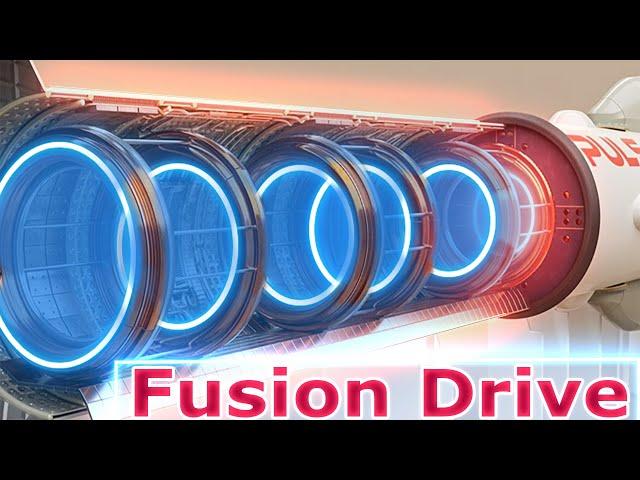Комментарии:

Tech Planet, If plasma power only needs a power supply, then this power source is possible right now. The project is unfunded, but the concept could deliver Mega-watts in a super small package ~ 1 Mega-watts for just 70 lbs. Power is developed using QED principles. Let me know if you're interested. -e
Ответить
So as it seems this would be something like pulse type of engines on Star Trek ships? Nice, aside from Alcubierre's warp drive this is second thing that goes into Star Trek direction.
Ответить
So you talk alot and don't see shit been talking about plasma for a long time I use plasma to cut heavy elements like Elon musk uses plasma for cutting and scrapping cnc machines uses plasma for cutting so when you find the technology call someone that actually uses the application
Ответить
Do you realize how much money making those con artists with fusion. Literally billions. Billions in contracts. It's just unbelievable...
Ответить
For storage of hydrogen as hydride, (Yb3H8), remains the highest hydride of ytterbium. Utilizing the diamond anvil cell methodology. This is a good fuel storage technique of value even for supersonic jets that presently carry more than 25,0000 liters of fuel for a single journey.
Ответить
"DESTROYS" = typical overly used hyperbole click bate exaggeration ... much better & correct word: "outperform" (low case letters)
Ответить
After that only space bending.
Ответить
Anything can cost less if its made in Abundance. The High cost of creating a new system like this is mitigated way down the line when it become commonplace.
Ответить
Sorry it's 96 megajoule in water it can feed itselfes with power! The extra input can be an extra layer of sunpanels on the wings! And battery storage a few supercaps.
Ответить
Darn even uses a redstone flux power supply!
Ответить
Just a minute in here, but do remember that fusion needs more shielding than fission. An open fusion reaction would spew out massive amounts of radiation, so we can't use this anywhere near our own atmosphere, this would only be useful for interplanetary or interstellar propulsion,
Ответить
I had to delete my comment because of Gustav Gnöttgen, I apologize to those who believed me. You will learn the accuracy of my success in antigravity in the coming years. I will delete this comment after a while.
Ответить
We've never even been to the moon tho 💀
Ответить
So ... a plasma-based rocket destroys rockets. Right? Plasma thrusters have already been used.
Ответить
any nuclear reactor which has infinite propellant, as millions times more energy storage density over conventional rocket fuels. yes even fission reactors. like photon radiation drive.
Ответить
At 400Mil Degrees you could easily make a bag of popcorn.
Ответить
All these different engine ideas are great, but im hearing that they not so good in Earth's atmosphere. So when are they going to run space tests?
Oh thats right, its too expensive to launch anything into space so those prototypes will never get there.
Is there any news on new launching systems to get craft into space?

"With enough energy".. so in the first 15 seconds you destroy the entire concept of reality of plasma engines.. You might as well be talking about Fusion energy. Its the same thing as Trump said in the debate.. I have concepts of a plan.
Ответить
the energy can replace the used energy back and forth to generate power using the outage of power to reimburse that same energy
Ответить
How can we invest in this?
Ответить
Goose eating his breakfast giggling...
Ответить
pipe dreams
Ответить
Check Out LPP Fusion.
They use turbulent flow to create the pinch and produce a plasma beam. This beam could be used for propulsion.
For energy generation the beam can be passed through an induction transformer to get electricity directly. No steam turbine. The pinch also produces a Flash of X-ray which can also be captured and turned into electricity.
I like this system as it has few moving parts, is compact, and lighter than other fusion attempts. Which means it could actually be viable as a propulsion system or energy generation system on a space craft where reliability, size, and mass are all key factors.

Deuterium? Now they just need some anti-deuterium and a few dilithium crystals...
Ответить
ZPE
Ответить
Блаблабла
Ответить
I think a microwave enhanced diode array laser with pulsing magnetic field to compress the flow where small amounts of ??? (maybe iron and hydrogen or carbon and hydrogen) are turned into plasma by the MASER could be fuel and energy efficient enough for long duration space travel.. A solar array to power this in the inner planetary zone would be large but not unrealistic as would a solar furnace.. A small to medium sized nuclear molten salt reactor running an ammonia vapor turbine would not be overly large as a primary or backup power source..
Ответить
they had the concept in the 1950 or earlier the impulsed was though to gain 10% of the speed of light but using atomic detonation pules there was also a jet intake model proposed that pulled in the suns exhaled plasma(which travels around 10 % the speed of light) and projectile vomited it out through several thrust increasing chambers to a theorized speed close to that of light ,so yeah its got lots of possibility in space why would you want to in the atmosphere fire a ball of plasma at high speed at some object em disturbing pretty colours
Ответить
131 star systems are within 6 parsecs of our solar system. If such a drive works potential long term probes could make such a journey to those stars within 20-100 years. That's a huge upgrade given the two Voyager probes have been going about 40 years & haven't reached the Oort cloud yet.
Ответить
It wouldn't require a fusion reactor. A regular fission reactor would do just as well.
Ответить
1st craft. Smallest payload, mostly just fuel. Leaves faint nearly undetectable matter trail of used fuel.
All following craft get tiny benefit from gathering/ramming the matter trail and ejecting it out the back

I can design things that depend on non-existent technologies too! A child can do that.
Ответить
Nice comprehensive analysis. Thank you.
Ответить
You make a nuclear powered airplane and problem solved.
Small modular reactors (SMRs) range from 20 to 300 megawatts and they are 100 to 1000 times smaller than their bigger counterparts.
6 pounds per kilowatt means you can have 120,000 to 1,800,000 pounds of thrust consistently for about 7 years straight...

This tech WILL be viable for spacecraft propulsion, but it is in its infancy so more time and research is needed. I wonder if anyone has thought of using isomers as a power source to "spark" the plasma drive? The US Dept of Defence is looking at isomer bombs, others are looking at isomers in super batteries.
Ответить
This sounds (and the visual sims look) a lot like how the sub light engines in Star Wars vehicles work.
Ответить
It can be the trust for the new start trek from the future
Ответить
Bye bye fission and combustion, hello fusion.
Ответить
Anything that produces thrust by expelling a propellant IS a rocket.
Ответить
The folly of all conventional fusion rockets is their over reliance on plasma made by fusion fuels. The plasma simply has not enough mass to be a viable alternative to a fission thermal rocket or particle beam propulsion. High thrust requires a lot of mass so you'll need a way to make sure that you insert extra propellent into the plasma. I think it's common knowledge that this is hard to do unless you greatly increase the complexity of the drive. Another important factor is radiation. Much of a fusion reaction's energy comes in the form of neutron and x-ray radiation. It's enough to vaporise any unprotected system near the plasma. A far more efficient alternative is pulsed fusion power. Take an orion drive, remove the pusher plate and install a (non ablative)heat shield instead. For a pusher plate, you activate a strong magnetic field just above the shield. Instead of nuclear bombs, we use fusion fuel encased in a ball of frozen water or something similar. At around 300 meters away from the craft, the fuel pellets are targeted by a laser. The temperature is enough to make the reaction happen and a large cloud of plasma appears. All of that plasma slams into the magnetic field and creates thrust. All in all, you have low complexity, no need for radiators and better efficiency.
Ответить
clickbait = don't recommend channel
Ответить
I hate it when a video uses clickbait titles. Leaving a dislike and blocking from recommendations.
Ответить
Sounds like they dont destroy regular rockets. Because they're not something we know how to utilize yet....thanks for lying right to my face.
Ответить
A very confused mashup of ideas that don't go together.
Ответить
What is this? Non of the depictions in the video have anything to do with what is said.
Ответить
This might as well be an Asimov short story.
Ответить
I-Cann II rocket concept from Pen State University claims 128 days. It is a hybrid nuclear pellet design that uses the nuclear pellet being detonated by antimatter using a storage container called a ping trap to hold antimatter.
Ответить
I believe that the engine you mentioned is the next step for space.
Ответить
Regardless of how they will do it. I don't want humanity to make a breakthrough, they are too irresponsible to deserve to use it.
Ответить









![[LIVE] Day Trading | How I Made $460 in 5 Minutes (from start to finish...) [LIVE] Day Trading | How I Made $460 in 5 Minutes (from start to finish...)](https://invideo.cc/img/upload/MDJWVDBnT2lRclM.jpg)
















